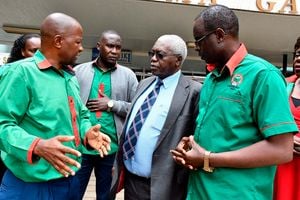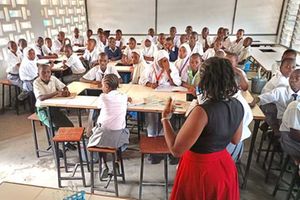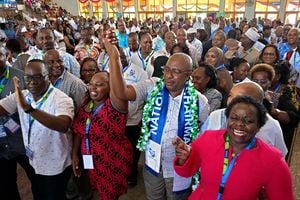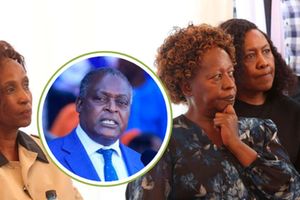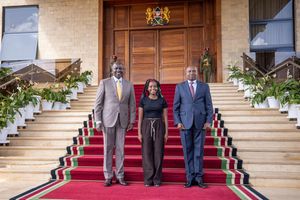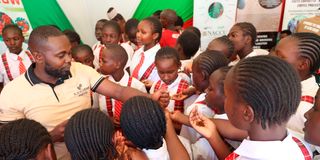
Mr John Ngugi of Rainforest Alliance and Jacaranda Junior Secondary School pupils during the Ruiru Coffee Fair at the Kenya Agricultural and Livestock Research Organisation in Ruiru, Kiambu County, on February 14, 2025.
The pioneer cohort of learners who will join Grade 10 (senior secondary) in January 2026 under the Competency-Based Curriculum (CBC) will select a total of 12 schools for placement to transition from junior school.
The learners, who are currently in Grade 9, will select schools based on their preferred career pathways, where they will focus on fewer subject areas that they would also wish to pursue in higher education. The placement will take place after the learners undertake the Kenya Junior Secondary School Assessment (KJSEA), which will be administered from October 27 to November 5, 2025.
This is according to draft guidelines on admission to senior school, developed by the Ministry of Education and seen by Nation, which will be launched in Machakos Town on Friday by the Cabinet Secretary, Julius Ogamba. The launch will pave the way for countrywide dialogues in all 47 counties from 9th to 15th March 2025.
Learners will select senior schools based on the career pathways they intend to pursue. The three pathways are: Science, Technology, Engineering and Mathematics (STEM), where the Ministry of Education (MoE) intends to place 60 per cent of the learners; the Arts and Sports Science Pathway (15 per cent); and the Social Sciences Pathway (25 per cent).
According to the CBC framework, the various pathways branch off into tracks, where learners select specific sbjects for their studies. Learner placement will be based on their performance in the KJSEA, which will comprise 20 per cent from the Kenya Primary School Education Assessment (KPSEA), 20 per cent from school-based assessments (SBAs) in Grades 7 and 8, and 60 per cent from a summative evaluation at the end of Grade 9.
Senior school learners (Grades 10-12) shall take seven subjects. Four of these are core subjects: English, Kiswahili/Kenya Sign Language (KSL), Community Service Learning, and Physical Education. The remaining three shall be selected from their chosen pathways and tracks.
Learners will select seven schools in which they wish to be placed for their first-choice pathway and track, three for their second-choice pathway and track, and two schools for their third-choice pathway and track.
Nine of these schools will be boarding schools—four from the learner’s home county and five from outside their home county or county of residence. The remaining three will be day schools in their home sub-county or county of residence. Senior schools, which will be the current secondary schools, will be categorised based on three factors: the career pathways they offer, accommodation type, and gender and special needs education considerations.
The guidelines further propose that the top two learners per gender in each STEM track per sub-county will be placed in a boarding school of their choice. Placement of all other candidates in boarding schools will be based on merit, choice, and a set quota, with the quotas intended to ensure equity through regional distribution. Consideration will also be given to whether learners attended public or private schools.
Additionally, the guidelines propose that no more than five learners from the same junior school shall be placed in the same boarding school.
The top-performing learner per gender in each Social Sciences track per sub-county will be placed in a boarding school of their choice. Similarly, the top-performing learner per gender in each Arts and Sports Science track per sub-county will be placed in a boarding school of their choice. For learners with special needs, candidates with an achievement level of 7 and 8 per track will be placed in a boarding school of their choice.
For learners with special needs, candidates with an achievement level of 7 and 8 per track will be placed in boarding schools of their choice.
For placement to the various pathways, learners the assessments they have been doing are meant to evaluate their interests, skills, values, aptitudes, and personality traits. The MoE guidelines anticipate situations where some learners or parents will be dissatisfied with the schools they will be placed to.
“Any grievances will be handled by MoE. The respective MoE offices shall address the grievance within the existing laws, regulations, policies, and established protocols. Complainants should channel their grievances through the head of the institution of their respective junior school to the county director of education,” the guidelines read.
The admission process will be automated, and letters of admission shall be accessed online using the learner’s assessment number. According to MoE, all schools, both public and private, shall admit learners to Grade 10 through the Kenya Education Management Information System.

